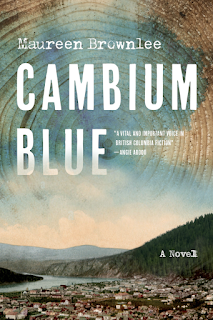Maureen Brownlee, Cambium Blue
"What a drag it is," as Mick Jagger sang, "getting old," but Jagger was so often wrong, wasn't he? Clearly he got plenty of satisfaction, after all, and it wasn't only rock and roll, either, even if he did like it.
I was fortunate enough this spring to be mailed a copy of Maureen Brownlee's new novel Cambium Blue, and I suspect that because in many ways I'm the right reader, I may not be the right reviewer for people unlike me. In brief, I don't know how many readers bring to this book the influences that make me appreciate it so very much, and I want it to find a great many readers who don't have the same background I do, because I'm confident they'll love it regardless. Still, Kerry Clare in Toronto opens her review with "Oh my gosh, I loved Maureen Brownlee's Cambium Blue from its first pages," so I'm optimistic!Several years ago, I also reviewed on this site Brownlee's first novel, Logger's Daughters. At the time, I wrote that it "gives its readers a brilliant, small-scale representation of a woman claiming her place in the world, anchored in a version of small-town 1980s BC that feels awfully true to me." If that sounds interesting to you, then you'll be at least as interested in Cambium Blue, which gives its readers more main characters and hence more variability in the perspectives we inhabit with them.
The novel interweaves three characters' lives, intersecting in the small fictional town of Beauty Creek, British Columbia. Not far from the Rocky Mountains, Beauty Creek is a straightforwardly classic version of not just a CanLit small town, but a recognizably BC small town. In other words, this is realist fiction that feels real, rather than unduly literary, both in spite of and because of its craft. Briefly:
- Nash Malone, a rough older man (and writer) who in the 1990s is still processing his time in the Great Depression and the Spanish Civil War, has long been a professional friend of
- Maggie Evans, who in her 50s has taken over editorship of her deceased husband's newspaper, and who eventually hires
- Stevie Jeffries, a young mother new to Beauty Creek with her own complicated backstory.
We move unhurriedly between these characters lives and perspectives, learning about what has brought them together in this place, about the deaths that have helped to define their lives, and about the relationship between stories on the one hand, and lives lived like stories on the other. (We tell ourselves stories about our own lives, don't we? Internally, even if not externally, and it's possible for such entanglements to control out lives.) In the background behind all this, too, are the beginnings of the 1990s pine-beetle epidemic in BC's forests, in which beetles turned the cambium of trees blue.
The question, really, is what kind of world we want to build together, even if in this case we're watching characters try to build and sustain the community of a single very small town. During this interminable pandemic, and in the face of climate change, I don't know that there's a more important question, and I so appreciated Brownlee's understated, quiet consideration of how one might survive the various crises that intersect in all our lives.
Cambium Blue is an unobtrusively fine novel, its craft obscured by the naturalness of its pacing and plotting, and I would've happily read another hundred pages. For me, I was incredibly taken by Nash Malone, and I'm putting him in my pantheon of Great Fictional BC Characters.
To be clear: I grew up outside a small town in the BC interior, in the 1970s and 1980s, and my father spent his career working at the lumber mill on Adams Lake. A few hundred kilometres north of that, you'll find Valemount, where Maureen Brownlee lives and which has a lot in common with the 1990s town Beauty Creek that's at the heart of Cambium Blue. Anyone who has any of that in common with either of us will absolutely find a lot to appreciate in this novel.
And if you don't trust me, and want to read a review long enough to include some spoilers and a detailed synopsis, then Ginny Ratsoy has you covered. Ratsoy appreciates Cambium Blue without loving it, in part because (as she says) it's "more a study of a culture than a character study," so she would've liked more interiority from the two women among the three main characters. If character is only part of fiction's attraction for you, that's not much of a worry.
Recommended!

Comments
(Sorry not to reply MUCH earlier....)